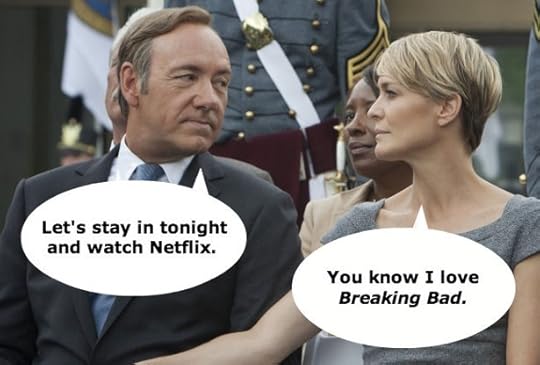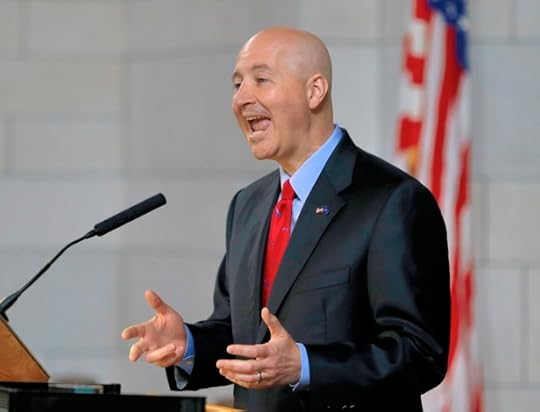Atlantic Monthly Contributors's Blog, page 420
June 6, 2015
Feminist Miss Piggy and TV Mothers: The Week in Pop-Culture Writing

Can Silicon Valley Fix Women’s Fashion?
Anne Helen Petersen | Buzzfeed
“As fashion scholar Minh-Ha T. Pham explains, that lack of sartorial confidence is linked to so many female failings ... Stitch Fix, Gwynnie Bee, and a phalanx of voices, from What Not to Wear to Oprah, posit well-fitting, fashionable clothes as a solution. Get rid of the mom jeans, these services and programs seem to suggest, and Live Your Best Life.”
The Calligraphy Stars of Instagram
Alexandra Lange | The New Yorker
“Recurring words in people’s comments are ‘mesmerizing,’ ‘hypnotic,’ and ‘satisfying.’ For reasons I don’t fully understand, people clearly enjoy watching the process of something perceived as ‘perfect’ being made from start to finish.”

Destroying L.A. and Female Rock Critics: The Week in Pop-Culture Writing
I Interviewed Mark Kozelek. He Called Me a ‘Bitch’ on Stage.
Laura Snapes | The Guardian
“If anything remains to separate Kozelek from his work, it’s that his music preaches that the least we owe one another is decency.”
On TV, Motherhood too Often Comes Across as Weakness
Stacia L. Brown | The Washington Post
“In real life, motherhood is no easy analogue for mercy, kindness or vulnerability. It can make a woman crueler as often as it can make her kinder.”
Miss Piggy: Why I Am a Feminist Pig
Miss Piggy | TIME
“And yes, it is true that I am a Porcine American. How can a ... ahem, pig ... be a feminist? After all, the p word has long been associated with the very antithesis of feminists ‘male chauvinist.’ This, alas, is a vestige of latent ‘species-ism.’”
The Charmed Life of Bob Saget
Ryan Bort | Esquire
“If you need a reminder of the breadth of Saget's appeal, go to one of his actual shows, where fans have paid to see Saget and Saget alone. Every age group is represented.”
The Real Teens of Silicon Valley
Nellie Bowles | The California Sunday Magazine
“Desai, while still in high school, made an iPhone game that sold 50,000 copies. ‘Who cares about grades after that?’ he said.”









June 5, 2015
The Double Bind of Voting Rights

If Hillary Clinton’s speech demanding voting-law reform was merely a political gambit, it seems to have worked.
On Thursday, the Democratic presidential hopeful delivered a forceful speech in which she called for voting-law reform. In particular, she said all Americans should be automatically registered to vote at 18 and for expanded hours and days of voting. Clinton also specifically called out several current or former Republican governors now seeking the GOP nomination for backing restrictive voting laws, including Rick Perry, Scott Walker, Jeb Bush and Chris Christie.
On Friday, Perry, Walker, and Christie fired back with criticism of Clinton. (Bush hasn’t yet responded.)
That seems like exactly the effect her campaign wanted in the immediate term. Clinton is unlikely to garner the same degree of enthusiasm that black voters gave to President Obama, so she’s seeking policy ideas to motivate the group. Defending voting laws is a way to demonstrate to minority voters that Clinton is concerned about their plight—and, of course, increasing the number of minority voters is also likely to benefit the Democratic Party and its standard bearer. By firing back at Clinton, Republicans took her bait and helped her make the point. (Not that replying won’t confer its own political advantages.)
My National Journal colleague Josh Kraushaar, among others, focuses on this political calculus. But Clinton is intervening in a long-running debate over laws imposing restrictions on voting, by limiting hours or requiring IDs. Republicans around the country have proposed, and often passed, such laws in recent years, arguing that they’re necessary to preserve the integrity of the vote. There’s little evidence, though, that voter-fraud is a widespread problem. It appears, in fact, to be exceedingly rare.
Supporters of these laws argue that even one fraudulent vote is a tragedy in a democracy. But to critics, preventing even one eligible voter from exercising the right to vote seems equally tragic. And that, in fact, that seems to be a much more common effect of these laws.
There’s ample evidence that doing things like restricting voting hours and eliminating early voting cuts into minority and low-income turnout, in part because members of these groups report that they don’t have the time to take off work during the day to vote. (That’s the rationale behind early and weekend voting, and also behind calls to either make Voting Day a national holiday or move it to a weekend.) And requiring voter IDs can also make it harder for people to vote, especially in states with idiosyncratic rules that, for example, make it legal to vote with a gun license but not a state-university ID. Official IDs are not always free, and they’re not always locally accessible.
Nate Silver looked at the literature on voter-ID laws a few years ago and concluded that although there’s lots of superficial disagreement, most studies come to a similar conclusion: The laws reduce turnout by about 2 percent of the registered number of voters in a state. John Sides did the same, but found the evidence inconclusive.
But whatever its merits, Clinton’s gambit also poses a political paradox. While Clinton’s proposals might lead to a fairer landscape for voters overall if enacted, the very gambit undermines itself. Because she’s the Democratic frontrunner, she is able to put the issue on the national agenda like no one else—as the last 24 hours have shown. But because she’s the Democratic frontrunner, she’s also likely to make the issue so politically toxic that no Republican will be willing to touch it. Since the Supreme Court struck down Section 5 of the Voting Rights Act, some Republicans—most notably Representative James Sensenbrenner—have voiced a desire to restore the law. Clinton’s proposal, of course, would push farther than that. If Clinton keeps speaking up, it’s likely to keep any Republicans from sticking their heads up to agree. And without voting-rights reform, it’s difficult for Democrats to turn out enough voters to secure the majorities necessary to overcome their opposition.
This isn’t a totally novel political dynamic. In fact, Democrats have seen a similar one on immigration very recently: Creating a path to citizenship for undocumented immigrants is thought to be a politically wise move for Democrats because it’s believed that it would create a large batch of new Democratic voters. Yet immigration reform remains deader than dead in Congress because it’s a Democratic political cause. The effect with voting laws is even more direct, since enacting Clinton’s reforms would instantly produce a new bunch of eligible likely Democrats.
That’s the trouble with disenfranchisement—it’s difficult for the disenfranchised to repeal.









Surviving Rock and Roll

Great art doesn’t require great suffering, but a lot of great art was created in the presence of it. The dangers of getting causation and correlation wrong in this case should be self-explanatory. “I always found the concept of a tortured artist distasteful,” Wilco’s Jeff Tweedy told The Los Angeles Times in 2011, talking about his journey from addiction to sobriety. “My distaste for it probably prevented me from getting help sooner. I didn’t want to admit that I was falling into a cliché.”
Related Story
Embracing the Myth of Kurt Cobain
And yet the cliché persists, in artists’ lives and, perhaps more commonly, in art about them. This year is big—though perhaps not bigger than any other—for art about troubled musicians. The documentaries Kurt Cobain: Montage of Heck (currently available on HBO Go) and Amy (as in Winehouse, in theaters July 10) tell of two iconic singers who died at age 27 after struggling with fame, depression, and drugs. And this week, the scripted film Love and Mercy tells of the Beach Boys’ Brian Wilson, who survived trauma but only barely. Thankfully, none of these films make rock-star self-destruction seem particularly glamorous. Watching them makes clear that while problems can feed music, music’s success can feed far greater problems—cliché or no.
Love and Mercy, directed by Bill Pohlad and written by Michael Alan Lerner and Oren Moverman, was made with Wilson’s approval but feels like anything but a safe, genre-conforming biopic. Rendered in bright colors and structured in stream-of-consciousness style, slipping back and forth between timelines, it’s a nearly surreal take on a surreal life, and it’s unflinching about the depths to which Wilson sank. The film actually features two Wilsons: the cherubic Paul Dano as the brilliant but strange 20-something Beach Boy, and the particularly haggard-seeming John Cusack as the middle-aged lost soul.
The younger Wilson stays in California as the rest of his band tours Japan, so as to work on Pet Sounds, the album that would secure the Beach Boys’ status as innovators. The sources of that innovation, as portrayed in the movie, are the sounds in Wilson’s head. There are scenes of him standing alone in rooms as droning noises and snippets of speech—arranged by Nine Inch Nails affiliate Atticus Ross—crowd in on the soundtrack while Dano looks around in wonder. There are other scenes of Wilson commanding the legendary collection of studio musicians known as The Wrecking Crew, urging them along to make the kinds of arrangements that had never been made before. But the source of brilliance is also a source of pain. The music gets better and better, but Dano’s mental illness gets worse, to the point where he’s babbling nonsense to his bandmates during serious meetings and canceling recording sessions because the vibes in the studio don’t agree with him.
While problems can feed music, music’s success can feed far greater problems.This depiction alone would be enough to explain the condition in which the elder Wilson enters the movie: wandering in a car dealership, muttering cryptically to a saleswoman named Melinda Ledbetter (played with intelligence and patience by Elizabeth Banks). But we soon learn that he’s under the prison-like care of Dr. Eugene Landy, the kind of menacing egomaniac Paul Giamatti was born to play. Whatever Wilson’s problems were in the 60s and 70s, the film makes them seem minor in comparison to the problems he had once Landy entered the picture. The therapist keeps him overmedicated, won’t let him leave the house without permission, and screams at him to make a new album and earn Landy money. Real-life spoiler: Wilson’s alive today and married to Ledbetter, the woman who rescued him.
Kurt Cobain and Amy Winehouse obviously can’t be compared directly to Wilson, or even to each other. They made different kinds of music, had different problems, and only Wilson lived past 27. But it’s hard to miss the similarities their documentaries have with each other and with Love and Mercy. These individuals were born with innate talent: Wilson’s creativity amazes and irritates his siblings, the opening clip of Amy is of her delivering a stunning rendition of “Happy Birthday” as a teenager, and the early moments of Montage of Heck feature family members talking about what a hyperactively creative kid Cobain was. But domestic trauma also figures heavily into these narratives. Both Cobain and Winehouse were apparently transformed by their parents’ divorce, and all three musicians had daddy issues. Cobain’s father is represented as emotionally distant, Winehouse’s manipulates her, and Wilson’s, as played by Bill Camp, is terrifyingly mean. Music is portrayed as being, in part, a reaction to tumultuous upbringings.
Drugs, on the other hand, aren’t depicted as fueling success. Instead, they’re a dangerous result of it. Winehouse and Cobain are shown as using heroin both to escape from the huge demands of fame and to bond with romantic partners. Wilson’s first on-screen hit of LSD happens at a party, compliments of some hipsters who’d been stroking his ego, and when Dr. Landy overmedicates Wilson, it’s in large part because of who he is, not the affliction he has. While there are no Landy-types in Cobain and Winehouse’s stories, the specter of exploitation looms large in Winehouse’s narrative in the form of family members, managers, and boyfriends. In all three stories, there’s great pressure on the artists to keep producing the kind of music that made them successful—and when the musicians can’t or don’t want to, they start spiraling downward.
Unsurprisingly, given how things ended up, the two documentaries leave viewers feeling pretty awful. Montage of Heck largely uses Cobain’s own words—interviews, drawing, journal entries, home videos—to document his despair and mounting inclination towards suicide at the end of his life. Amy relies on horrifying paparazzi footage and clips of her stumbling around on stage in her final years, partaking in the same voyeurism that tormented her. Wilson’s tale, by contrast, is strangely inspiring. For however scarring the journey and for however much help it took to get him healthy, the fact that he lives today offers some hope in a culture obsessed with the destruction of the artist.









Israel and Saudi Arabia: Togetherish at Last?

The United States stands to see impressive progress on a longstanding foreign-policy wish this month.
No, not curbing Iran’s nuclear program—though negotiations on a deal with Tehran remain on the front burner as a June 30 deadline approaches. But the American-helmed effort to reach a deal with Iran has so rattled the Middle East that it has had the effect of hastening rapprochement between Israel and Arab nations.
Israel and Saudi Arabia don’t have diplomatic relations and never have, but on Thursday, the two countries revealed at an event at the Council on Foreign Relations in Washington that they’ve been covertly conducting diplomacy to discuss Iran over a series of five meetings since 2014. The reveal came from Anwar Eshki, a former Saudi general and ambassador to the U.S., and Dore Gold, a former Israeli ambassador to the UN. While both of them are currently think-tankers, Gold is set to become director-general of Israel’s Ministry of Foreign Affairs this weekend, the top position below the foreign minister. Since Prime Minister Benjamin Netanyahu holds that portfolio, Gold will effectively be running the office.
Both countries have been rattled by worries that a deal negotiated by the U.S., Iran, and several other countries to curb Iran’s nuclear program could give Iran too much leeway and pave the way for it to get nuclear weapons. They’re also worried about Iran’s growing strength as a regional power. In addition to backing Hezbollah, a constant antagonist of Israel, for years, Tehran has become involved on Saudi Arabia’s southern border in Yemen in recent months with its backing of the Houthi rebels who ousted Yemen’s president in January. Given Saudi military action against the Houthis, Yemen’s civil war has elements of a proxy war between Saudi Arabia and Iran.
"Our standing today on this stage does not mean we have resolved all the differences that our countries have shared over the years," Dore said, according to Bloomberg View’s Eli Lake. "But our hope is we will be able to address them fully in the years ahead."
Eshki’s prepared remarks offered a potted history of the Middle East, laying out what he viewed as Iran’s imperial plan. And he offered a seven-point plan for peace in the region, kicking off with peace between Israel and Arab nations and, next, regime-change in Iran. (The plan also includes the creation of a new state of Greater Kurdistan including parts of Iran, Iraq, and Turkey.)
"Our standing today on this stage does not mean we have resolved all the differences that our countries have shared over the years."Eshki and Gold also shook hands on stage.
The CFR event isn’t the only sign of some friendliness between Israel and Saudi Arabia. There have been reports about secret collaboration for years, often denied by both governments. A 2009 report said that Saudi Arabia had offered to let Israel fly over Saudi territory to attack Iran, a report Israel knocked down. Another report claimed that Israel had offered its “Iron Dome” missile-defense technology to Saudi Arabia for use in Yemen in the proxy battle. A survey released Thursday found that Saudi citizens are far more concerned about Iran than the Zionist state. “The poll found that 53 percent of Saudis named Iran as their main adversary, while 22 percent said it is the Islamic State group and only 18 percent said Israel,” the AP noted.
None of this should be taken to understate the enduring enmity between Israel and Saudi Arabia—despite U.S. attempts over the years to bring about better relations between its two most important regional allies. Not only have the countries never had diplomatic relations, but there’s been enduring tension between them for decades. The Saudis and Egyptians long jostled for primacy in the Arab world, and Riyadh resoundingly rejected the Camp David Accords establishing peace and diplomatic relations between Israel and Egypt. Saudi Arabia remains party to an Arab League boycott of Israeli goods.
But Saudi Arabia is wary of Hamas, and it remained notably quiet during Israel’s bombing campaign against the Hamas-controlled Gaza Strip last year. The Saudis have tried to make their Arab Peace Initiative the centerpiece of regional deal, which Netanyahu has declined to do.
It’s a little ironic that Iranian progress toward a bomb has driven Saudi Arabia toward Israel. While Saudi Arabia does not have a nuclear-weapons program, it has flirted with the idea repeatedly over the years, citing Israel’s widely known but never publicly acknowledged nukes. In a recent interview with my colleague Jeffrey Goldberg, President Obama projected confidence that Saudi Arabia wouldn’t seek its own bomb. “They understand that ultimately their own security and defense is much better served by working with us,” he said.
But if this rapprochement is real—and Elliott Abrams, who chaired the CFR session, offers some reasons to be optimistic but tempered—it may be that the Saudis would rather cast their lot with Israel than with a U.S. government they think is giving too much away to Iran. And that points to the remaining barriers the U.S. has in selling the nuclear deal to its allies. Washington may finally be seeing an opening in Israeli-Saudi relations, but it just goes to show that you should be careful what you wish for—or at least be careful about how you get it.









Women's Soccer Is a Feminist Issue

When I told my friends and family I’d be going to Brazil for the World Cup last year, they looked at me like I’d just won the lottery. In a sense, I had; I’d entered a lottery just to be able to purchase tickets. In Recife, I attended games at a brand-new stadium with a bright-green grass pitch, along with 40,000 other soccer fans from around the world. For months leading up to the event I saw news coverage on TV, in newspapers, and in magazines hyping Team USA, even though they had a virtually nonexistent chance of victory. By the time I left for Brazil, friends who I never knew to be soccer fans were telling me who their favorite players were, jealous that I would see “our boys” play against the tournament favorites, Germany.
Related Story
‘Pele With a Skirt’: The Unequal Fortunes of Brazil's Soccer Stars
This year, I’m going to the World Cup again. There was no lottery, and tickets were half the cost of the ones I bought last year, including a ticket to the final. (Which, last year, would have been nearly impossible to come by, not to mention afford.) The games I’ll attend this month will be played at a 32-year-old stadium with an artificial-turf field. Some of the games in the tournament will be played at a stadium with 10,000 seats, while the smallest stadium in Brazil seated 37,634. Even though this year Team USA are favorites to win, there’s been little preview coverage of the tournament. When I tell people I’m going, most of them say, “There’s a World Cup this year?” There is, only it’s being played by women, not men.
Starting this month, millions of viewers will watch women’s soccer on television, and even start to recognize players by their first names. Some might wonder why audiences only see these world-class players, like Abby Wambach, who holds the international goal-scoring record—for women and men—for a few weeks every two years at the World Cup or the Olympics. But most, even those who care about equality for women, won’t consider how different these athletes’ careers are compared to those of men who do the exact same thing for a living.
Today, the gap between men’s and women’s wages, the tiny fraction of female CEOs at Fortune 500 companies, and the lack of respect for Hollywood actresses and directors receive regular and impassioned coverage in both the mainstream and feminist media. The gender inequities in sports are just as vast as those faced by women in corporate offices and on movie sets, but for some reason they fail to incite the same level of outrage.
In 1978, in the midst of the second-wave feminist movement, Hollis Elkins, a professor of women’s studies at the University of New Mexico, Albuquerque, published a paper that asked why the women’s movement hadn’t ever concerned itself with equality in sports. (This was six years after the passage of Title IX, which prohibited sex discrimination in federally funded schools, including in athletic departments.) Elkins died in 2013, but if she were alive today, she’d likely still be asking the same question.
Elkins laid out four main reasons why the women’s movement was wary about involving itself in sports. One: Female athletes were perceived as either unconcerned with or hostile toward the women’s movement. Two: Feminists didn’t want to be “doubly damned” by “the suspicion of lesbianism” that both feminists and female athletes faced. Three: Sports was seen as a realm where men proved their manliness, negatively predisposing many feminists toward sports in general. And four: Sports was considered “frivolous.” It wasn’t seen as being as important as issues like the right to work, abortion, and equal pay.
Sports was considered a “frivolous” issue. It wasn’t seen as being as important as issues like the right to work, abortion, and equal pay.In October of last year, the biggest names in women’s soccer did something unprecedented: They sued the world soccer governing body. A group of top international players including Wambach, Brazil’s Marta, and Germany’s Nadine Angerer filed a gender-discrimination lawsuit against the Canadian Soccer Association and FIFA citing the fact that this year’s World Cup in Canada would be played on artificial turf instead of natural grass. All six prior women’s World Cups, and all 20 men’s, have been played on grass fields, because it’s considered a superior playing surface. Simply by pointing to gender discrimination, the lawsuit did something female athletes don’t usually do.
“There’s a major fear of the explicit use of the term feminism to sell women’s soccer,” says Rachel Allison, a professor of sociology at Mississippi State University who has studied women’s professional soccer. “The one major event that’s broken that trend is the FIFA turf lawsuit.”
When this explicitly feminist issue arose, it went unmentioned on websites such as Jezebel, Everyday Feminism, and The Feminist Wire. Ms. Magazine’s blog wrote one post on the issue with no follow-up, and Feministing.com posted one link to an outside story on the topic in a news roundup-type post.
This isn’t the first time feminist issues in sports have gone relatively unnoticed by sites that focus on women’s issues. In 2012, Jezebel and Feministing both lamented the folding of the Women’s Professional Soccer league, though neither site had covered the league in any prior stories. And neither Jezebel, Feministing, Everyday Feminism, nor The Feminist Wire have ever run a story on the current women’s league, the National Women’s Soccer League. Ms. has published one blog post about an NWSL team, written by a fan.
“It’s not like we never thought about sports stories,” says Dodai Stewart, the former deputy editor of Jezebel. “If there were notable newsy things happening in the world of women’s sports we would cover that. But it wasn’t like we were existing for sports coverage. In the atmosphere we were in, it just didn’t feel like, ‘oh, this thing is lacking,’ even though it was.”
The problem is, sports media isn’t covering women’s sports either. In 2014, ESPN’s SportsCenter dedicated 2 percent of its on-air time to covering women’s sports, according to a study published this week in the journal Communication & Sport. The study found that three local Los Angeles news networks did slightly better, devoting 3.2 percent of their sports coverage to women athletes.
Cheryl Cooky, one of the study’s co-authors and a professor of women’s studies at Purdue, says these numbers are actually lower than they were when this study began 25 years ago. But even this clearly unequal treatment is difficult for people to understand as sexist.
The thinking goes that if women’s sports were worthy of more coverage, they would receive it.“There’s still this cultural investment in the idea that sport is this space wherein talent and hard work is what matters, and things like race, gender and sexual orientation don’t,” Cooky says. The thinking goes that if women’s sports were worthy of more coverage, they would receive it. But as Cooky points out, a lot of our perceptions of how interesting women’s sports are come from the media itself. “Men’s sports are going to seem more exciting,” she says. “They have higher production values, higher-quality coverage, and higher-quality commentary ... When you watch women’s sports, and there are fewer camera angles, fewer cuts to shot, fewer instant replays, yeah, it’s going to seem to be a slower game, [and] it’s going to seem to be less exciting.”
***
In Seattle, where I live, the men’s professional soccer team, the Sounders, draws 44,000 fans on average to every home game. The women’s professional soccer team, the Reign, draws 3,500. This disparity exists in a place where, while I was growing up, the majority of boys and girls I knew played on a soccer team, at a time when Brandi Chastain’s game-winning penalty kick to win the 1999 women’s World Cup was the most memorable sports moment any of us had been alive to see.
The Reign isn’t lacking star power. U.S. national-team superstars Hope Solo and Megan Rapinoe are on its roster. To be fair, the Reign is only in its third season of existence. But the Seattle Sounders are only in their eighth year in the MLS, and by their third year, they were averaging 36,000 fans per game at CenturyLink Field, where the Seattle Seahawks play.
Kiana Coleman, co-founder of the Royal Guard, the main supporter group for the Seattle Reign, points to the dearth of media coverage.
“Most people, even soccer fans around here, don’t even know the team exists,” she says. “How would they? Women’s soccer isn’t on ESPN except for the World Cup. I’ve sent messages to [local news station] KING 5 ... The Mariners could be in a deep, dark hole and they still don’t cover the Reign. Last year, we [almost] never lost, and still nothing.”
This disparity in coverage is gender inequality at work, says Cooky. “The media plays a huge role in building and sustaining audiences for sport and they do it very well for men’s sports and they do it horribly for women’s sports.” The World Cup, when more Americans watch and get excited about women’s soccer, proves her point.
It’s a chicken and an egg problem, says Allison, the Mississippi State professor. “This huge media platform doesn't exist for the national league. So media often tells the women’s league, you don’t have the level of interest we need to make this successful. But that narrative falls apart when we see how they are able to do just that with the World Cup.”
***
“When people find out you're a professional soccer player, they think it’s awesome,” says Jazmine Reeves, Rookie of the Year for the NWSL’s Boston Breakers in 2014. “But they think it’s awesome because there are certain assumptions that go along with the life of being a professional athlete. And they don’t realize that for us [women], it’s kind of like the exact opposite.”
Last year The New York Times ran an article on the tight financial circumstances many male professional soccer players face in the still-fledgling MLS. “Many in MLS Playing Largely for Love of the Game,” read the headline. The minimum salary? $36,500.
Reeves made $11,000 last season, more than the 2014 NWSL league minimum of $6,000, but less than a third of what her male peers were making. The team tried to offset her expenses, as it does with many players, by placing Reeves with a host family in Boston during the season so she wouldn’t have to pay rent. “My host family was great, but at the same time, as an adult, you want to be able to pay for your own apartment,” she says.
This season, the NWSL minimum went up to $6,842. The MLS minimum jumped to $60,000 thanks to a contract renegotiation. Still peanuts compared to male professional athletes in the MLB, NBA, or NFL, but at least it’s a salary, not a four-figure joke.
“I never really thought about it until I was playing professionally,” Reeves says. “Then I realized, wow, there’s a team down the street from us playing in Gillette Stadium and we can’t even get a consistent training field half the time ... You can’t deny the fact that there’s a pattern.”
“My host family was great, but at the same time, as an adult, you want to be able to pay for your own apartment,” Reeves says.Reeves does see hope in the way one city embraced its female players. “I did not feel like a professional athlete until we went to Portland,” she says. She likely won’t be on the field to see NWSL’s future, however. At the end of the season, at age 22, she retired from professional soccer to take a job with Amazon.
What Reeves felt during that game against the Portland Thorns was the effect of 14,383 fans dressed in Thorns red packing the same stadium where the MLS’ Portland Timbers play. At their home games a rowdy crowd waves flags, sings songs and performs cheers led by Capos, fans who stand with their backs to the field the entire game simply to fire up the crowd. In other words, Reeves played in an environment very similar to the one most men’s professional soccer teams experience.
In some ways Portland, where soccer scarves—often representing both the Timbers and the Thorns—hang from the walls and ceilings of bars across the city, is uniquely set up to support a women’s soccer team. The Portland MLS and NWSL teams have the same ownership, a distinction shared by just one other of the nine NWSL teams in the league. And it helps that the Timbers are incredibly popular. The waiting list for Timbers season tickets is reportedly more than 10,000 strong. Providence Park, where the teams play, holds 22,000. Marketing the Thorns to these soccer-hungry fans is a no-brainer.
“When the [Thorns] team was announced people stepped up immediately and said we want to make sure the support for them is equal to that for the Timbers,” says Kristen Gehrke, one of the leaders of the Rose City Riveters, the main Thorns supporter group.
But without a built-in MLS infrastructure that promises media, advertising, and audience support, the NWSL fan base in most cities has struggled. Not counting Portland, the average attendance in 2014 was a little less than 3,000, with many of those being families or youth-soccer players.
The Thorns prove that a deeper and more diverse fan base exists for women’s soccer when male and female teams are treated more equally. Hours before the kickoff of a Thorns game against the Washington Spirit in Portland in May, Thorns jerseys could be spotted on the streets of the city. And though the stadium filled with many young soccer players and families early on, groups of 20- and 30-somethings of both genders filled many of the seats before the first whistle, as well as the bars near the stadium before and after the game.
So why, in 2015, is sports, a multi-billion dollar industry that so many take so seriously, still seen as a “frivolous” issue by many feminists, as Elkins suggested in 1978? There are a few small groups advocating for more women coaches and better treatment for women athletes. But according to Allison, “even in the academy, studying sports is often considered a less serious pursuit than studying the economy, or politics.”
And that, says Cooky, is wrong. Feminists need to focus on sports because it’s an institution of massive cultural significance and an area rife with “serious” issues, such as sexual violence, pay inequality, and a lack of women in leadership positions. “Who wouldn’t want to do what they love and say that’s their job?” says Reeves. “I’m not saying I would never play again, but I can’t live off of what they gave me. I can’t.”









The Spy Who Crushed It

“Desk duty,” according to the longstanding lore of the spy movie, is a punishment—for going rogue, for fumbling a mission, for generally failing in the line of duty. For Susan Cooper, however, desk duty isn’t retribution. It’s a full-time job. Cooper (Melissa McCarthy), a CIA agent whose agent-ing is done in a vermin-infested basement in Langley, is a spy who is treated like a secretary: Competent and cooperative, she Gal Fridays agents in the field to successful missions by way of cameras and earpieces. She hears “I couldn’t have done it without you” a lot. But her success as a secret operative is, for the most part, only vicarious. Susan’s spy name, she informs a fellow desk-bound agent, would be “Meatball Martin Luther King Jr. Avenue.”
Related Story
Susan is also, inconveniently, in love with the field agent she works with most closely, the James Bondian Bradley Fine (Jude Law, doing a passable British person's version of an American accent)—who acknowledges her feelings by variously insulting her, taking advantage of her, flirting with her, demeaning her, and complimenting her. Taking her out to a fancy dinner to express his gratitude for her assistance (“I couldn’t have done it without you”), he gives her a necklace—packaged, to add insult to injury, in a ring-sized jewelry box—whose pendant is a comically large, anthropomorphized cupcake. “I know how much you like cake!” he explains.
Susan is, in other words, the woman many woman struggle against becoming: unsatisfied, accommodating to a fault, in love in a way that is literally hopeless. She is very much not, we are meant to understand, Living Her Best Life. All of this, however, belies the most salient fact about Susan Cooper, CIA agent: She is extremely good at her job. She is smart and resourceful and patient and steady in a crisis. When people tell her they couldn’t do it without her, they mean it. So when Fine is taken out of commission by the Bulgarian arms dealer Rayna Boyanov (Rose Byrne, doing a passable Australian person's version of a British accent)—and when Rayna reveals that she’s in possession of a nuclear bomb that she has hidden in Europe—Susan volunteers to take Fine’s place in the field. Partly because of the hopelessly-in-love thing, but partly, too, out of the conviction that she’d be just as good away from the desk as behind it.
The CIA’s head spy, Elaine Crocker (the wonderfully deadpan Allison Janney), approves the scheme. Since Rayna has figured out who their current field agents are, they conclude that they need someone “invisible” to track her to the bomb. And Susan, Crocker informs her, dead-panningly, is the most invisible person they can think of.
Much of the comedy in the first half of Spy comes from the insults casually lobbed at Susan—about her appearance, about her demeanor, about her gender. CIA engineers, preparing her for the field, give her new identities, all of them in the “cat lady” vein (one of them: a divorced housewife from Iowa who sells Mary Kay makeup and collects porcelain dolls; another: a single mother of four who is excessively fond of sweatshirts). They provide her not with the tools typical of Hollywood secret-agent badassery—lipstick daggers, collapsible guns—but rather with the stuff of supposedly sad single womanhood: a blow-dart in the guise of a rape whistle, chloroform in the guise of hemorrhoid wipes, poison antidote in the guise of stool softener. The engineers of Langley also give her a night-vision scope housed in a Beaches watch, and a hairstyle reminiscent of the one Vicki Lawrence wore in Mama's Family. This is the stuff of Miss Congeniality, basically, only Susan’s makeover swaps a bandage dress for a sweatshirt festooned with cats. “I look like someone's homophobic aunt!” Cooper complains, legitimately.
This is the stuff of Miss Congeniality, only Susan’s makeover swaps a bandage dress for a sweatshirt festooned with cats.So it’s pleasantly jarring when Spy’s real transformation takes place, and when it becomes clear that the change will have very little to do with Susan’s appearance. She uses her time in the field to come into her own—as an agent, but also as a more basic badass. She’s fast with a gun and even faster with a quip. She’ll find a way, if the situation calls for it, to weaponize a cast-iron skillet.
Susan’s job in the field—a traipse around Europe that includes stops in mansions and casinos and nightclubs in Paris, Rome, and Budapest—is to “track and report,” gleaning intel about Byrne but not interacting with her. When things go predictably awry, Susan ends up interacting not just with Rayna, but also with a menagerie of murderers who are working both with and against the arms dealer. She does so with the help of her friend Nancy (Miranda Hart), who takes over as Langley’s designated earpiece whisperer, and of Aldo (“like the shoe store found in American malls!”), an aggressively amorous Italian agent (Peter Serafinowicz). She does so, also, in spite of the appearance and reappearance of Rick Ford (the several-scene-stealing Jason Statham)—a rogue agent who has endured, and survived, pretty much every type of torture (bombs, gun shots, dips into tubs of acid) that the James Bondian canon has to offer, and who, like pretty much everyone else in this fictional CIA, is a fan of insult comedy.
“Are you going to seduce him?” Rick asks a cat-ladified Susan, of a target.
“Why is that so hard to believe?” she shoots back.
“Because,” he replies, “you look like a flute player in a wedding band.”
But while Spy threatens, at first, to become that most boring of things—an extended joke about a fat lady—it transforms that threat the way Susan transforms herself. The takedowns that animate the film are buoyed by sharp, sitcomic writing (“could this hotel be more murdery?” Susan asks of her Paris digs) and by plots that twist with the speed of any good thriller. Just as Susan abruptly evolves, so does the movie’s scope. The insults soon get aimed at people who are more deserving of them: incompetent colleagues, international arms dealers, incompetent international arms dealers, etc.
Spy is ultimately yet another version of the oldest story there is: the story of a woman who is way more badass than she seems to be.Spy is also redeemed, more importantly, by the fact that Susan herself is never the butt of any of the comedy here—not really. She is insulted, repeatedly, but the jokes here are ultimately directed not at Susan herself (who doesn’t, after all, get all gooey around a crush? what kind of monster doesn't like cake?). They’re directed instead at a culture that treats someone like her as, in every sense but the most literal one, invisible. Spy isn’t simply a send-up of James Bond and Jack Bauer and Jason Bourne and every other spy who has enjoyed the initials of JB; it also satirizes a society that can so stubbornly refuse to see people for who and what they really are. Spies traffic in covert identities; so, writer/director Paul Feig suggests, do people like Susan Cooper—people whose awesome is obscured by other people’s failures of vision.
Which makes Spy, ultimately, yet another incarnation of the oldest tale there is: the story of a woman who is way more badass than she seems to be. It’s Cinderella and Pretty Woman and The Sound of Music and The Princess Diaries and She’s All That and pretty much every teen movie ever made, only with blow-darts and Lear Jets and vom jokes. But the badassery, importantly, is defined here not by looks or the interest of princes, but by competence. Spy is about women—field agents, support agents, criminals, bosses in every sense of the word—who are very good at their jobs. It is also about men who are not very good at theirs. There's Ford, all swagger and silliness; there’s Fine, simpering and suave and smarmy. Susan, in the field, dispatches with men quickly and easily; it’s the women who put up a fight.
In that, Spy is in league with so many other movies of this summer—Pitch Perfect 2, Mad Max: Fury Road, the recently announced, all-female Ghostbusters (another McCarthy/Feig collaboration)—and of years past (Bridesmaids). These are films that are, like Spy, notably casual in their feminism. Their celebration of female accomplishment and friendship doesn’t announce itself, in spotlit Beyoncé fashion; it just is. These movies ace the Bechdel test. But they do it quietly. They certainly don’t congratulate themselves for it. They suggest, all in all, that the unassuming woman Aldo ends up referring to as “lady super spy Susan Cooper” is at once exceptional and not at all an exception. They suggest that it is possible to be humble and successful at the same time. And they suggest that feminism itself can be that way, too. “I’m not one to toot my own horn,” Cooper says of her super-spying. “But you know what? I'm gonna toot.”









Sense8: The Premise Is Not Enough

Stop me if you’ve heard this one before: A group of strangers’ lives intersect in unexpected ways. It’s one of the most elemental story setups that exists. Are we talking Lost? Speed? Contagion? Golden Girls? Or are we talking about the story of mankind itself?
One not-too-uncommon twist on the premise takes it abstract, ratcheting up the strangeness of the strangers and playing coy about how exactly they intersect. Crash, Babel, and the entire rom-com genre spawned by Love, Actually follow lives that touch one another only glancingly. A recent boomlet of novels, like Jennifer Egan’s Pulitzer-winning A Visit From the Goon Squad and David Mitchell’s Cloud Atlas and The Bone Clocks, hopscotch between characters separated by the places they live, the voices in which they speak, and the decades they’re born in. Often, the reader’s left to guess at why the various chapters from different points of view exist as part of the same book.
Related Story
When, Exactly, Does Watching a Lot of Netflix Become a 'Binge'?
When they work, stories like these can make even the most jaded consumer of culture get a little giddy about humanity’s vastness and its interconnectedness. But to do so, each individual character’s story has to hold the reader or viewer’s interest. Some chapters of Cloud Atlas and Goon Squad could work as self-contained short stories. Some actually have.
Sense8, the new Netflix show from the Wachowskis (the siblings who created The Matrix) and J. Michael Straczynski (the showrunner for Babylon 5), would like to join this tradition. The Wachowskis already oversaw the big-budget 2012 adaptation of Cloud Atlas, which earnestly tried to evoke the magic of Mitchell’s novel, made up of disparate narratives that spanned from the 1800s to a future century. (It flopped.) Sense8 is all set in the present, but the premise is just as hydra-like: Eight random people scattered all over the globe—a cop in Chicago, a bus driver in Nairobi, a businesswoman in Seoul, etc.—find their minds suddenly linked in mysterious ways, for mysterious reasons.
It’s a cool idea that pays off with some spine-tingling moments in the three episodes screened for critics. The characters peer into one another’s realities, feel one another’s feelings, and share one another’s skills only in fits and starts—most often in moments of high drama, either because of the way that the mind connection works in the show’s universe or because of the need for contrivance in any television story. Towards the end of one episode, a hijacking unfolds in Africa as a kickboxing match goes down in South Korea, resulting in a cross-continental martial-arts sequence. At another moment, love scenes transpire in India, Germany, and Mexico, resulting in some amusingly overlapping emotions for those involved.
But gosh-wow moments like those are rare, at least so far. Most of the screen time fleshes out the eight fairly banal principals’ lives. This affords the show the chance to dabble in an array of classic film situations: a Bollywood dance routine, a cop ride-along, a criminal’s safecracking. It also affords the program some refreshing diversity in regards to race and, more notably, sex and sexuality. Two gay couples figure in prominently, and the protagonist with perhaps the most screen time is a transgender woman. Still, many of these stories feel familiar. Does the sensitive Chicago cop have a hard-drinking dad and a partner skeptical of his compassion? Does the transgender activist—she prefers “hacktivist”—have a controlling, disapproving mother who insists on calling her by her male birth name? Of course and of course.
As has happened so many times in the Wachowskis’ career, you’re left wishing they’d been paid for their initial idea and that the execution had been left entirely to someone else. The wooden solemnity of Keanu Reaves et. al in The Matrix is proven again to be less of an aesthetic feature of that particular movie and more a result of how the filmmakers direct their actors. Outside of some neat crosscutting between story-lines, the Wachowskis’ visual sensibility hasn’t evolved much either. The title sequence is a good indication: It’s made up of not-particularly-well-framed postcard shots from around the world, presented at an iPhoto automated slideshow tempo, with fonts and music that might have seemed edgy on a mid-‘90s Prodigy album. Bloat is a problem, too. Into this mesh of stories, why add further clutter via flashbacks featuring different actors?
Some clunkiness and blah characterization would be acceptable if the overarching story held attention. But three episodes in, the connected-minds premise has only occasionally figured into the narrative, with almost no explanation for what’s going on. It’s not that the show relies on mystery too much; it’s that it doesn’t rely on it enough, at least not yet. Episodes end on cliffhangers based on car chases and boxing matches and other dramatic happenings that would be part of the characters’ lives regardless of the supernatural meta-plot, and given that those lives aren’t all that riveting, the viewer’s not left itching for the next episode.
It’s not that the show relies on mystery too much; it’s that it doesn’t rely on it enough.It’s frustrating, because there are flashes of fascination in here. The way that the emotions and visions of the “sensates” bleed together resembles mental illness, and is often treated as such. The same fantasy of The Matrix, that one could download a life’s worth of knowledge into the brain, is present here, but with a metaphorical twist—know-how comes from connecting to another person, not to a vast technological network. And some of the individual plotlines are more charming than others; a comical one featuring a closeted actor and his “beard” entertainingly shows the movie star trying to use his professional acting abilities in his private life.
But the momentum simply isn’t there. The disconnected stories of Cloud Atlas that the Wachowskis so admired worked on the page because David Mitchell is a talented wordsmith with a knack for suspense. Love, Actually, for whatever else you might say about it, packed in enough wit and sentiment so as to not bore people. The medium isn’t the problem: The sprawling, often disconnected ensemble of Game of Thrones hangs together on the strength of scene-to-scene acting and writing. Sense8 thinks as big as any of these works, but botches the small stuff, and the result is a show about humanity where it’s hard to care about any of the humans.









What's Causing Baltimore's Crime Spike?

Baltimore residents seem to be facing an impossible dilemma: They can have abusive policing, or hardly any at all.
The first option was abundantly well-documented in the days after Freddie Gray’s death: the history of rough rides and brutality; the repeated inattention to emergencies; the unwise tactical decisions. Since the city exploded, then calmed down, residents are starting to get a feel for their other choice.
As The Baltimore Sun noted over the weekend, May saw the most murders in any month in Charm City since 1972. Non-lethal shootings have gone up sharply as well. But arrests are down across the city—there were 1,177 arrests in May 2015, as compared to 3,801 in May 2014. The idea that lower arrests are ipso facto a bad thing should not go unchallenged: Critics of broken-windows style policing say that there have been too many arrests for petty or irrelevant crimes. Such overly aggressive policing has driven a wedge between the community and the cops. Freddie Gray was almost certainly a victim of excessive arrests—he was detained only for running away from police, and the the prosecutor and officers differ on whether the knife they found in his pocket once he was handcuffed was legal or not.
But Baltimoreans in places like Gray’s neighborhood of Sandtown didn’t say they wanted no policing. NPR talked to West Baltimoreans who complained that calls they placed to 911 to complain about crimes have gone without any response—sometimes dozens of them.
Related Story
The Benefits of Fewer NYPD Arrests
Yet no one can pinpoint what exactly is behind the spike in crime and dive in arrests. Those residents and some civil-rights advocates think the police are intentionally backing off of enforcing crimes—like going on a strike, but not as radical. A slowdown would be to both punish citizens for lashing out against the police and also to create a sort of cautionary statement: This is what your streets will look like without cops. Is that really what you want?
A notable example of a police slowdown came in New York City early in the year, when cops—upset at Mayor Bill de Blasio’s implication of racism in policing—basically stopped arresting people. But the NYPD slowdown was notably different in several respects. First, and perhaps most importantly, the move was a tremendous propaganda failure. Crime actually fell during the slowdown, reducing arrests actually played into the mayor’s strategy, and public opinion swung against the police. The spike in crime in Baltimore looks very different. Second, NYPD officers were a little more open about what was happening. While no union declared a slowdown, the police commissioner acknowledged that’s what was going on and cracked down on it.
In Baltimore, neither the Fraternal Order of Police nor Police Commissioner Anthony Batts say there’s a slowdown. That’s notable because Batts and the FOP have, by and large, been at each others’ throats since the Gray protests.
Batts has several explanations for what’s happening. One is a flood of prescription drugs on the street, being used for recreational purposes, that were looted from pharmacies during the April rioting. "There's enough narcotics on the streets of Baltimore to keep it intoxicated for a year," Batts said Wednesday. "That amount of drugs has thrown off the balance on the streets of Baltimore." (This is, City Paper notes, a bit exaggerated.) Batts also said that officers have been patrolling in pairs rather than the normal solo beats, which effectively halves the number of patrols.
The FOP offers a bleaker, though related, rationale for the decrease in arrests: Officers are afraid, its leader says. On the one hand, they’re beset by hostile citizens who carefully monitor every arrest, crowding around officers who are just trying to do their jobs and capturing the detentions on camera, lest they turn into another Freddie Gray situation. On the other hand, police are also afraid a prosecutor will haul them in front of a jury. After Baltimore City State’s Attorney Marilyn Mosby charged six of their comrades with a range of offenses in Freddie Gray’s death, they say that they don’t know when they might be charged with a crime, just for doing their jobs.
Of these, the second concern seems more potent. "The criminals are taking advantage of the situation in Baltimore since the unrest," said local FOP President Gene Ryan. "Criminals feel empowered now. There is no respect. Police are under siege in every quarter. They are more afraid of going to jail for doing their jobs properly than they are of getting shot on duty."
How seriously can that charge be taken? The FOP has been harshly critical of Mosby since she announced her intention to charge the officers. But it’s not as if there’s been a spate of prosecutions. The prosecutor has brought charges against six officers in one very specific case—a case in which a suspect was put in a police van alive and exited it less than an hour later, unable to breathe and near death. When officers cite the fear of prosecution, they risk sending the message that they can’t do their job of keeping Baltimore safe without abusing citizens and opening themselves to charges.
“Criminals feel empowered now. There is no respect. Police are under siege in every quarter.”Batts’s solution to the crime spike has been to ask for more assistance from the federal government. The Justice Department is already investigating the Baltimore Police Department, at its leaders’ request, and Batts is asking for more help from federal law-enforcement agents to tamp down violence.
A widely read May 29 column by Heather Mac Donald tried to place Baltimore’s crime surge in a national context. Citing increases in crime in other cities across the nation, Mac Donald argues that what we’re witnessing is a “Ferguson effect,” as police get nervous about enforcing laws and criminals feel more leeway to, well, do some crimes. There are a couple of issues with Mac Donald’s thesis. One is that crime always tends to increase as the weather gets warmer. As Jason Linkins notes, Mac Donald also does some mixing and matching of numbers, and her year-over-year totals can skip over the fact that violent crime nationwide remains at historical lows. She may be right, but it’s too soon to draw real conclusions about trends in crime, much less their causes.
More disturbing, though, is the way that Mac Donald frames her conclusions. The wave of reforms pushed by politicians from de Blasio to former Attorney General Eric Holder, she argues, may be producing unintended consequences: “If these decriminalization and deincarceration policies backfire, the people most harmed will be their supposed beneficiaries: blacks, since they are disproportionately victimized by crime.”
Mac Donald is right about who the victims are likely to be. But can it really be that citizens have to choose between living with rampant crime, or accepting racially slanted policing that arrests, incarcerates, and marks with a criminal record a disproportionate share of African Americans? That’s no choice at all.









Out of Spite: The Governor of Nebraska’s Threat to Execute Prisoners

“A punitive impulse has controlled criminal justice in America for almost half a century,” Columbia law professor Robert Ferguson writes in his searing book, Inferno: An Anatomy of American Punishment. Surveying law, history, philosophy, and literature, Ferguson grapples with Americans’s peculiar commitment to punishment (rather than, say, rehabilitation, justice, or utility) as the aim of our justice system. “American attitudes toward legal punishment have entered a fantasy land of inconsistencies so intense that there seems to be no possible return to reality,” Ferguson told me recently.
And that was even before Governor Pete Ricketts of Nebraska threatened to begin executing prisoners more or less out of spite.
On May 27, a coalition of Democrats and Republicans in the Nebraska Legislature approved LB268, which abolishes the state’s death penalty. Ricketts had vetoed the measure, but the legislature overrode his veto. Ricketts called for a voter referendum to overturn the repeal; then he said that the state would execute the ten prisoners currently under sentence of death anyway, using sodium thiopental imported from India.* Meanwhile, Senator Bill Kintner of the unicameral legislature sought to explain his support for executions by posting a photo of a beheaded woman on his Facebook page.
Let’s peel back the layers of lawlessness. Ricketts argues that the legislature cannot reduce a criminal sentence imposed by a court. Under Article IV Section 13 of the constitution, he’s probably right about the sentences. But by law, an execution also requires a death warrant, and in Nebraska only the state supreme court can issue one. The attorney general, Doug Peterson, can petition the court to set new execution dates, but it’s unlikely to do so before the law goes into effect in September.
There’s a second level: After it takes effect, LB268 doesn’t suspend lethal injection, as a court decision might; it repeals every provision that allows executions of any kind. After September, those condemned prisoners may still be formally under sentence of death; but no court will have jurisdiction to issue a death warrant, and no official will have authority to carry one out. What will Ricketts do then?
Layer three is the bootleg sodium thiopental. Ricketts says the state has ordered and paid for (but not yet received) this drug, part of the standard three-drug “cocktail” used since the 1980s for lethal injection, from a distributor named Harris Pharma, run by Chris Harris. The state bought some thiopental through Harris Pharma once before. The federal Drug Enforcement Administration seized that shipment because the company isn’t approved to sell it. (Harris had gotten it from a Swiss company by lying about what he was going to do with it.) Now the Food and Drug Administration is under a 2013 order from the D.C. Circuit to seize all sodium thiopental coming into the United States from unregistered dealers like Harris Pharma.
So what? Nebraska isn’t bound by the D.C. Circuit decision, Peterson told a newspaper; the state wasn’t a party to the case. True enough: The order binds the FDA, not the government of any state. But Eric Shumsky, who argued the D.C. Circuit case, told me that, under the court’s order, the FDA is required to seize any shipment at the border. There’s no way for Nebraska to get its drug supply—“unless they plan to smuggle it in in someone’s backpack,” he said.
The governor’s office did not return a call. Asked about the prisoners already on death row, Suzanne Gage, Peterson’s director of communications, said that “it is our intent to pursue a court determination as to their status and the ramifications of LB268 on the state’s ability to carry out the death penalty.”
The confusion in Nebraska—a cross between comic opera and banana-republic politics— follows closely on a surreal lethal-injection argument at the United States Supreme Court on April 29. The three petitioners in Glossip v. Gross have been on death row for between ten and 35 years. They don’t claim to be innocent; they don’t challenge the state’s constitutional power to put them to death; they ask only that the state not use untested drugs to kill them—drugs that, some evidence shows, may make their deaths as painful as being burned alive.
Under Eighth Amendment caselaw, Glossip is a hard case. But the legalities fell away when Justice Samuel Alito asked this question: “Is it appropriate for the judiciary to countenance what amounts to a guerilla war against the death penalty which consists of efforts to make it impossible for the States to obtain drugs that could be used to carry out capital punishment with little, if any, pain?”
Justice Antonin Scalia elaborated that the approved “drugs have been rendered unavailable by the abolitionist movement putting pressure on the companies that manufacture them so that the States cannot obtain those two other drugs. And now you want to come before the Court and say, well, this third drug is not 100 percent sure. ... [T]he abolitionists have rendered it impossible to get the 100 percent sure drugs, and you think we should not view that as—as relevant to the decision that—that you're putting before us?”
Scalia’s colloquy, along with Alito’s evident fury, was among the most bizarre I have ever seen in the Court chamber. Even The Washington Post’s George Will felt obliged to reprove his fellow conservatives: “The answers are: Public agitation against capital punishment is not relevant to judicial reasoning,” he wrote. “And it is not the judiciary’s business to worry that a ruling might seem to ‘countenance’ this or that social advocacy.” Ken Jost of Jost on Justice wrote that “Alito’s critique wrongly conjures up images of massive civil disobedience or direct action by death penalty opponents.” That hasn’t happened. In Jost’s column, University of Richmond Professor James Gibson (who has written a detailed article on the drug shortage) rejected the idea of “guerrilla warfare.” In an email, Gibson elaborated that the current shortage is “caused by political speech and foreign legislation.”
Under the First Amendment, criticizing the death penalty, even effectively, is as protected as, say, corporate electioneering expenditures. Judges have no right to expect “abolitionists” to be silent—as long as they remain within the law. And on that point, I can’t find a single documented case of threatening or harassing speech by “abolitionists.” In a 2012 brief, the Texas Department of Criminal Safety called the British non-profit Reprieve “authoritarian ideologues who menace and harass private citizens” and compared them to a Texas prison gang. The TDCJ warned that “Reprieve's unrestrained harassment will escalate into violence against a supplier.”
It’s been three years, and, though apparently a few pickets once showed up at a compounding pharmacy in the outskirts of Houston, the wave of violence hasn’t appeared. There don’t even appear to be any open investigations of “harassment” in Texas. It seems likely that Reprieve’s real offense is effectiveness. Among its other work, it lobbies European drug companies to keep their drugs from being used in executions; that’s the “pressure” that Scalia found so irritating. But that entirely legal use of speech works because it is in the companies’ legal interest to listen.
Why? Capital punishment is forbidden in the European Union. The EU has embargoed sale of lethal-injection drugs because EU human-rights law regards executions as a violation on a par with torture. American states are not obliged to agree; but they have no moral right to demand that EU companies break their own law. The U.S. can refuse to sell Kim Jong Un chemicals for weaponry; the EU can lawfully prohibit selling this country chemicals for killing.
Ricketts and Peterson are throwing a fit because the legislature did something they didn’t like, and they are threatening to shred state and federal law in response; Alito and Scalia threw a tantrum on the bench because the argument over capital punishment isn’t going their way.
Ferguson, in Inferno, links punitive attitudes to “pride in the claim of American exceptionalism.” Because America is special, the “exceptionalist” believes that “none of the moderate punishment regimes that exist in Europe apply in principle here,” he argues. Europe’s implied reproof—you are not stronger, you are weaker; you are not angels of righteousness, you are human-rights abusers; you are not guardians of justice, you are outlaws—enrages some powerful Americans.
More and more, across the world, the law itself condemns the use of poisons for “legal” killing. The stern mask of American justice is being stripped away; behind it we can see an angry snarl.
Nebraska's Governor Threatens to Execute Prisoners Out of Spite

“A punitive impulse has controlled criminal justice in America for almost half a century,” Columbia law professor Robert Ferguson writes in his searing book, Inferno: An Anatomy of American Punishment. Surveying law, history, philosophy, and literature, Ferguson grapples with Americans’s peculiar commitment to punishment (rather than, say, rehabilitation, justice, or utility) as the aim of our justice system. “American attitudes toward legal punishment have entered a fantasy land of inconsistencies so intense that there seems to be no possible return to reality,” Ferguson told me recently.
And that was even before Governor Pete Ricketts of Nebraska threatened to begin executing prisoners more or less out of spite.
On May 27, a coalition of Democrats and Republicans in the Nebraska Legislature approved LB268, which abolishes the state’s death penalty. Ricketts had vetoed the measure, but the legislature overrode his veto. Ricketts called for a voter referendum to overturn the repeal; then he said that the state would execute the ten prisoners currently under sentence of death anyway, using sodium thiopental imported from India.* Meanwhile, Senator Bill Kintner of the unicameral legislature sought to explain his support for executions by posting a photo of a beheaded woman on his Facebook page.
Let’s peel back the layers of lawlessness. Ricketts argues that the legislature cannot reduce a criminal sentence imposed by a court. Under Article IV Section 13 of the constitution, he’s probably right about the sentences. But by law, an execution also requires a death warrant, and in Nebraska only the state supreme court can issue one. The attorney general, Doug Peterson, can petition the court to set new execution dates, but it’s unlikely to do so before the law goes into effect in September.
There’s a second level: After it takes effect, LB268 doesn’t suspend lethal injection, as a court decision might; it repeals every provision that allows executions of any kind. After September, those condemned prisoners may still be formally under sentence of death; but no court will have jurisdiction to issue a death warrant, and no official will have authority to carry one out. What will Ricketts do then?
Layer three is the bootleg sodium thiopental. Ricketts says the state has ordered and paid for (but not yet received) this drug, part of the standard three-drug “cocktail” used since the 1980s for lethal injection, from a distributor named Harris Pharma, run by Chris Harris. The state bought some thiopental through Harris Pharma once before. The federal Drug Enforcement Administration seized that shipment because the company isn’t approved to sell it. (Harris had gotten it from a Swiss company by lying about what he was going to do with it.) Now the Food and Drug Administration is under a 2013 order from the D.C. Circuit to seize all sodium thiopental coming into the United States from unregistered dealers like Harris Pharma.
So what? Nebraska isn’t bound by the D.C. Circuit decision, Peterson told a newspaper; the state wasn’t a party to the case. True enough: The order binds the FDA, not the government of any state. But Eric Shumsky, who argued the D.C. Circuit case, told me that, under the court’s order, the FDA is required to seize any shipment at the border. There’s no way for Nebraska to get its drug supply—“unless they plan to smuggle it in in someone’s backpack,” he said.
The governor’s office did not return a call. Asked about the prisoners already on death row, Suzanne Gage, Peterson’s director of communications, said that “it is our intent to pursue a court determination as to their status and the ramifications of LB268 on the state’s ability to carry out the death penalty.”
The confusion in Nebraska—a cross between comic opera and banana-republic politics— follows closely on a surreal lethal-injection argument at the United States Supreme Court on April 29. The three petitioners in Glossip v. Gross have been on death row for between ten and 35 years. They don’t claim to be innocent; they don’t challenge the state’s constitutional power to put them to death; they ask only that the state not use untested drugs to kill them—drugs that, some evidence shows, may make their deaths as painful as being burned alive.
Under Eighth Amendment caselaw, Glossip is a hard case. But the legalities fell away when Justice Samuel Alito asked this question: “Is it appropriate for the judiciary to countenance what amounts to a guerilla war against the death penalty which consists of efforts to make it impossible for the States to obtain drugs that could be used to carry out capital punishment with little, if any, pain?”
Justice Antonin Scalia elaborated that the approved “drugs have been rendered unavailable by the abolitionist movement putting pressure on the companies that manufacture them so that the States cannot obtain those two other drugs. And now you want to come before the Court and say, well, this third drug is not 100 percent sure. ... [T]he abolitionists have rendered it impossible to get the 100 percent sure drugs, and you think we should not view that as—as relevant to the decision that—that you're putting before us?”
Scalia’s colloquy, along with Alito’s evident fury, was among the most bizarre I have ever seen in the Court chamber. Even The Washington Post’s George Will felt obliged to reprove his fellow conservatives: “The answers are: Public agitation against capital punishment is not relevant to judicial reasoning,” he wrote. “And it is not the judiciary’s business to worry that a ruling might seem to ‘countenance’ this or that social advocacy.” Ken Jost of Jost on Justice wrote that “Alito’s critique wrongly conjures up images of massive civil disobedience or direct action by death penalty opponents.” That hasn’t happened. In Jost’s column, University of Richmond Professor James Gibson (who has written a detailed article on the drug shortage) rejected the idea of “guerrilla warfare.” In an email, Gibson elaborated that the current shortage is “caused by political speech and foreign legislation.”
Under the First Amendment, criticizing the death penalty, even effectively, is as protected as, say, corporate electioneering expenditures. Judges have no right to expect “abolitionists” to be silent—as long as they remain within the law. And on that point, I can’t find a single documented case of threatening or harassing speech by “abolitionists.” In a 2012 brief, the Texas Department of Criminal Safety called the British non-profit Reprieve “authoritarian ideologues who menace and harass private citizens” and compared them to a Texas prison gang. The TDCJ warned that “Reprieve's unrestrained harassment will escalate into violence against a supplier.”
It’s been three years, and, though apparently a few pickets once showed up at a compounding pharmacy in the outskirts of Houston, the wave of violence hasn’t appeared. There don’t even appear to be any open investigations of “harassment” in Texas. It seems likely that Reprieve’s real offense is effectiveness. Among its other work, it lobbies European drug companies to keep their drugs from being used in executions; that’s the “pressure” that Scalia found so irritating. But that entirely legal use of speech works because it is in the companies’ legal interest to listen.
Why? Capital punishment is forbidden in the European Union. The EU has embargoed sale of lethal-injection drugs because EU human-rights law regards executions as a violation on a par with torture. American states are not obliged to agree; but they have no moral right to demand that EU companies break their own law. The U.S. can refuse to sell Kim Jong Un chemicals for weaponry; the EU can lawfully prohibit selling this country chemicals for killing.
Ricketts and Peterson are throwing a fit because the legislature did something they didn’t like, and they are threatening to shred state and federal law in response; Alito and Scalia threw a tantrum on the bench because the argument over capital punishment isn’t going their way.
Ferguson, in Inferno, links punitive attitudes to “pride in the claim of American exceptionalism.” Because America is special, the “exceptionalist” believes that “none of the moderate punishment regimes that exist in Europe apply in principle here,” he argues. Europe’s implied reproof—you are not stronger, you are weaker; you are not angels of righteousness, you are human-rights abusers; you are not guardians of justice, you are outlaws—enrages some powerful Americans.
More and more, across the world, the law itself condemns the use of poisons for “legal” killing. The stern mask of American justice is being stripped away; behind it we can see an angry snarl.
Atlantic Monthly Contributors's Blog
- Atlantic Monthly Contributors's profile
- 1 follower











